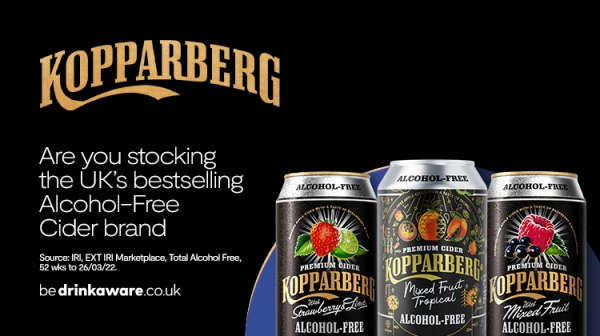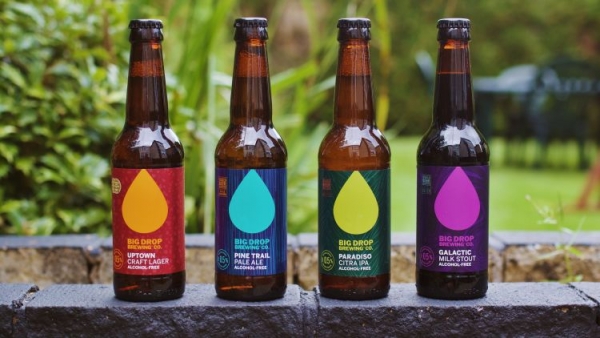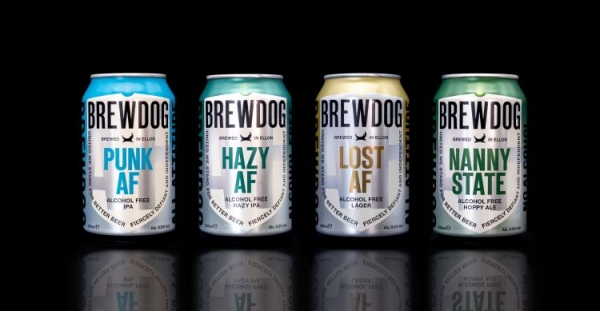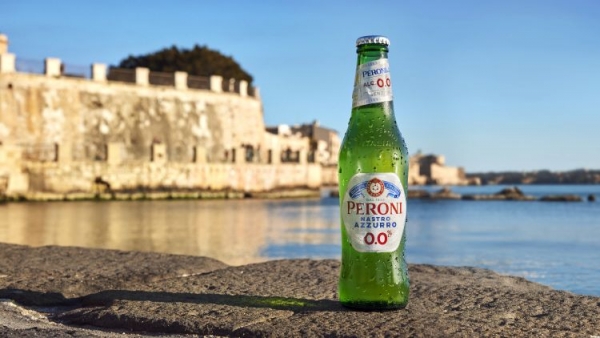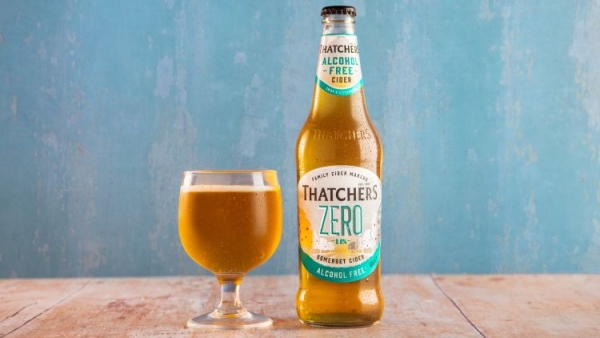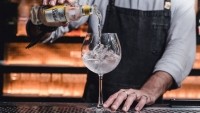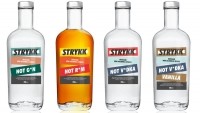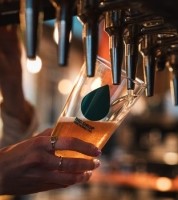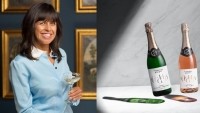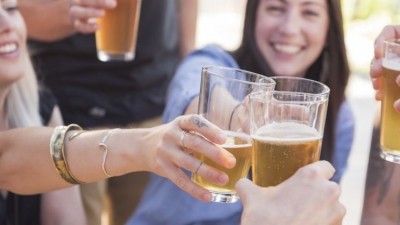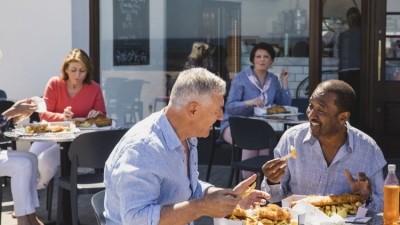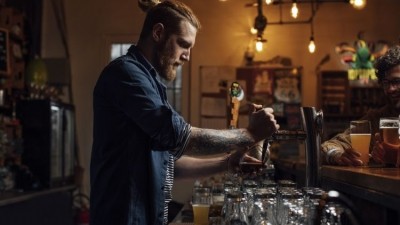Low to no drinks feature
FEATURE: Why low and no alcohol is not a compromise
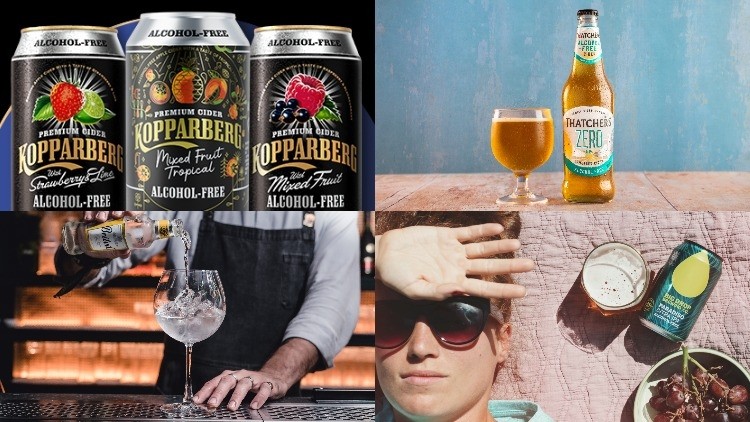
Kopparberg
As more consumers look to moderate their alcohol intake, offering a carefully considered alcohol-free range is an easy way to drive increased spend through your tills by driving trade up from lower priced alternatives. To ensure you service as wide a customer base as possible, in an efficient manner, look to offer breadth of choice (not depth), as opposed to different brands within the same proposition. Take cider for example: a strong alcohol-free range should offer a fruit cider and an apple cider, with the potential for a second fruit cider if space allows. As the best-selling alcohol-free cider brand in the UK1, and with more customers than any other alcohol-free brand2, Kopparberg is a must stock in this space.
Building on Kopparberg’s position as the UK’s favourite cider brand3, successful expansion into the alcohol-free category was made possible by developing a liquid that tastes very similar to the full alcohol version; delivering premium fruit refreshment without the alcohol content. This has led to Kopparberg having more unique drinkers than any other alcohol-free brand; in fact 17.2% of all alcohol-free drinkers only drink Kopparberg products2.
As consumers are increasingly making more considered choices about alcohol consumption and beer gardens swell with the warmer weather, it’s vital to stock the category’s leading brands to meet your customers needs, making your venue a trusted destination and keep them coming back for more.
Sources: 1. IRI, EXT IRI Marketplace, Total Alcohol Free, 52 wks to 26/03/22., 2. Kantar Worldpanel, Total Market, Total No/Low, Unique shopper share, 52w/e to October 2021., 3. Savanta Top 100 Most Loved Drinks Brands report, n=48,000, Jan ‘21-Jun ’21.
For more details, visit https://kopparberg.co.uk/cider-flavours/
The growth in low and no alcohol has been quite dramatic over the past few years. Who would have ever thought that consumers would be asking for a non-alcoholic beer or G&T? But it is a growing trend and licensees need to make sure they are catering for this market as the warmer months start to arrive.
People may want to enjoy low and no alcohol drinks for a variety of reasons – they may be teetotal, want to moderate their intake, be the designated driver, pregnant or even just want to lose those few extra pounds for holiday. But whatever the reason, it looks like a trend that is set to stay.
Research by the Portman Group shows that almost one in three (32%) of UK drinkers ‘semi-regularly’ consume low and no alcohol products compared to one in four (25%) in 2020. A fifth (20%) of people who have tried low and no alcohol say they are more likely to drink these products now compared to a year ago, a figure that has almost doubled since the previous year’s survey (11%).
The increased interest in low and no alcohol is something that has been seen by Tom Ward, founder and chief executive of Wise Bar Trader, the alcohol-free trade store, who argues that January 2022 didn’t create the sales spike that the traditional month of abstinence once did but that monthly sales are more even as people drink less alcohol all year round.
“Although consumer interest in a wider range of alcohol-free drinks is helping to drive demand in hospitality venues, some operators are still hesitant to experiment and incorporate a varied alcohol-free range into their drinks menu, often because they are simply not familiar with the choice available,” he says.
“For those who do recognise the potential for product diversification and extending their knowledge and range, however, there are more opportunities than ever to attract non-drinkers into venue.”
(back to top)
Beer
This revolution in low and no really started in the beer sector with small entrepreneurial operators along with larger brewers recognising the growing pace of consumer interest in the category.
According to IWSR analysts low and no-alcohol beer is currently the fastest growing segment in the UK, and it forecasts that it will grow by 6% per annum on average by 2023.
Big Drop Brewery was one of the first entrants into sector in 2016 with its non-alcoholic beers and now supplies a wide range of operators from Oakman Inns to Mitchells & Butlers.
James Kindred, Big Drop co-founder and chief brand officer, says that operators are becoming far more open to having no-alcohol as an option and consumers want it as they are now being more mindful about what they are drinking.
“It is not just the lunchtime crowd or the weekend crowd it is also the evening crowd as well. People are thinking about how productive they are going to need to be the next day or how busy their lifestyle is,” Kindred says.
Kindred says the craft beer revolution opened people up to the quality and variety of beers, meaning consumers won’t compromise on taste whatever the ABV.
“The one thing we are trying to do is help the pubs and bars understand the opportunity with no and low and there is an educational piece with the licensees,” he says.
Rupert Thompson, managing director, Hogs Back Brewery, that has its own Little Swine, a 2.8% ABV low-alcohol beer, says that has consumers have become more familiar with the sector, more demanding and unwilling to compromise on taste.
“As the no and low sector has grown brewers have become better at creating beers that have lower alcohol content, without sacrificing flavour, which is certainly what drinkers want today,” Thompson says.
Ben Lockwood, marketing manager on trade, BrewDog agrees that the growth in quality has helped the category.
BrewDog’s own research commissioned with KAM Media highlighted that 74% of pub and bar customers would consider buying alcohol free beer if it was available. It also highlighted that alcohol free beer has the potential to drive an additional £72m to the channel by driving uplift across all key performance measures, including: 20% increase in visiting occasions, 16% increase in footfall across different days and day parts, 26% increase in party size, 18% increase in frequency of visit, 18% increase in spend per visit and 25% additional dwell time.
“We are already seeing consumers become more aware of the quality and consistency of the products now available in the low and no space and demanding more from suppliers,” Lockwood says.
“It’s also important to give these products pride of place in terms of positioning in the fridge, on the back bar, and on menus, making them as easy for the consumer to find as possible.”
Meanwhile, Heineken UK on-trade category and commercial strategy director Charlie Fryday believes summer is an opportunity to bolster drinks sales and especially premium drinks sales.
“When consumers are moderating their drinking, they tend to remain category loyal,” he says. “So, a customer who typically drinks apple cider will look for a non-alcoholic cider – meaning if there are only low and no lager options then they will be forced to compromise. Offer breadth of choice in your venue (low and no options to cover the different drinks categories) rather than depth of choice (for example, multiple low and no premium lager brands). We suggest building your low and no alcohol range by sub-category to ensure it spans lager, apple cider, flavoured cider, ale, wines and spirits.
“On-trade customers also remain format loyal within the low and no alcohol category. This means if they regularly drink draught beer, they are unlikely to swap to bottles. Operators can drive incremental sales by having a non-alcoholic beer on draught, with 94% of beer sold in this format (CGA Strategy 04.12.21). Consider stocking Heineken 0.0 in both packaged and on draught or SmartDispense Blade to appeal to both needs.”
Asahi recently introduced Peroni Nastro Azzurro 0.0%, and says that pub operators need to cater and adapt their offer to be representative of their expected demographic.
“Once, the range is in place, operators can encourage consumers to choose these products with A-boards outside, internal promotional posters, table talkers and responsible drinking campaigns, all communicating the options available and the merits of forgoing alcohol,” Sam Rhodes, marketing director at Asahi UK.
He suggests that designated drivers could be offered a small bar snack or discount on food when purchasing an alcohol-free drink.
“It is also essential that bar staff are fully trained to answer any questions on alcohol-free drinks and offer flights or tasters, to be able to dispel the myth that no and low-alcohol versions of a brand means a compromise on taste,” adds Rhodes.
Erdinger, which has its Alkoholfrei, also says it is the occasion that can drive that non-alcoholic beer sale. Erdinger Alkoholfrei supports those with an active lifestyle with the isotonic recovery drink is served at marathon, triathlon and cycling events around the country.
Peter Gowans, UK country manager Erdinger Alkoholfrei, says: “The low and no-alcohol drinks category is thriving so should no longer be consigned to the bottom of the fridge or the back bar – make a feature out of your range so that customers know instantly where to look when choosing and create some theatre out of the presentation and serve to ensure it is every bit as exciting as your range of alcoholic drinks.”
Thatchers
Quenching your customers’ thirst for alcohol-free cider
Thatchers Zero will quench your customers’ thirst for a premium, alcohol-free cider. Thanks to its blend of bitter-sweet apples expertly crafted by Thatchers cider makers to create an alcohol-free cider with body, smoothness and character, Thatchers Zero is now the UK’s favourite alcohol-free apple cider*.
With its crisp, medium dry character and fruity aroma, Thatchers Zero retains the taste and character of a true cider but without the alcohol. This makes Thatchers Zero an essential for any pub or bar looking to offer a stand-out premium alcohol-free range, and the first choice for drinkers who don’t want to compromise on taste and enjoyment.
Family run Thatchers has a passion for making the best quality ciders sustainably, always putting its heart and soul into cider making.
Enhancing your range of alcohol-free drinks, adding value and driving incremental sales, Thatchers Zero is a must stock this summer.
*Source: IRI 52 w/e 26 Mar, 2022
(back to top)
Cider
Another category that has embraced the no and low alcohol category is that of cider. It is well suited for that summer drinking and the no and low variants are no different.
Thatchers Cider launched its own zero variant in bottle format at the beginning of 2020 after a two-year development process to get the taste of a proper cider. It is now its fifth best-selling bottled cider.
“We are pretty innovative and always looking at what the best next thing is. To be able to get the taste and quality that we needed took a bit of time. But we have got there,” says Rob Sandall, on trade sales director.
“I think people are looking to seek out pubs with gardens and those in the countryside and people need to drive. That just lends itself to having a no and low alcohol alternative.”
And licensees are recognising this is an important category as summer approaches.
“The feedback from publicans is that people get it. Customers are coming in and saying what have you got that is no and low alcohol and when they are given a choice – which is normally only two or three choices – we are really the only cider. It is not a hard sell at all,” he adds.
This summer he advises licensees to make sure their no and low range is on
on the menu, available on the app and visible in the fridge.
“Ideally if they have a selection of no and low alcohol beers and ciders they should be together in a back bar display,” he adds.
Making the alcohol-free products visible to the consumer is an approach supported Kopparberg, the Swedish fruit cider.
“The main consideration when selling alcohol-free products is that consumers choose their drink the exact same way, they would a full alcohol version,” says Tom Holmes, senior customer marketing manager, at Kopparberg.
“After deciding they don’t want an alcoholic drink, they choose the type of drink they want (beer, cider, wine etc.), before then choosing the flavour and brand. Bear this is mind when setting up menus, ensuring your alcohol-free range is a section on its own and is then structured by breaking out the individual sub-categories within it.”
The consumer demand mean that there is a need for greater choice in venues ensuring customers can choose between multiple different types of alcohol-free drinks.
“Take cider for example; a strong alcohol-free range should offer a fruit cider and an apple cider, with the potential for a second fruit cider if space allows,” Holmes adds.
But it is not just the major cider brands that are tapping into this changing demand. Maison Sassy, the Normandy cider produces its own zero abv and lower alcohol versions.
“We don't always want to have full strength bottles or pints when we visit the pub as it isn't sustainable for a full working week, so why not have an option that allows you to work after a pub lunch or get up in the morning without a sore head,” says Alexander Darley, head of sales.
He says that with the summer season no and lighter alcohol options work well with food.
This is a view supported by Anna Chalov, co-founder of Bemuse low-alcohol mead, the traditional blend of water and honey.
“Suggesting low-alcohol drinks to pair with food instantly increases the opportunity to upsell for those customers who have chosen not to drink alcohol and who would not otherwise consider selecting a drink to complement their meal,” Chalov advises.
“Stocking the right selection of low-alcohol and alcohol-free drinks can help differentiate a menu by offering a range of cocktails that is more appealing and adventurous than the traditional virgin pina colada, mary or mojito.”
Britvic
Britvic director of Foodservice & Licensed Adam Russell gives his advice.
Top tips for low and no alcohol success:
- Make time for low and no: Explore different opportunities throughout the day, for example, those looking to go for a drink midweek may prefer a low and no option if they are working. Try creating a happy hour across your mocktail menu for this reason
- Give low and no menu visibility: the menu is the first-place consumers look to choose low and no drinks, with 45% using it to do so10. Consumers also state that low and no should have its own section on the menu*
- Make low and no visible at the bar: in licensed outlets, product visibility is key. Stronger shelf call-out, more prominent displays and POS are all critical components in ensuring that your products are seen first and foremost
Dan Crowther and Jonathan Lee, owners of Hedonist Drinks, a Leeds-based bar that has pioneered low and no alcohol cocktails at their venue said: “There are so many ways to start building no and low drinks for your menu. Our methodology starts with our Project One movement – which was the UK’s first ‘one unit’ cocktail menu, created to capitalise on the trend of healthy eating, healthy drinking and a general increase of self-awareness of personal health.
“To start, challenge your team to create drinks with the sole requirement of only containing one unit of alcohol. The team can use any products they like, and then the ABV level can be measured. If the alcohol level is too high, at this point the recipe can be changed and adapted to bring it down.
“If you are looking to make a drink that is 100% alcohol-free, start with the base non-alcoholic spirit or think about the flavour profile that you want the drink to have – then utilise drinks that will achieve this.”
For more details, visit: https://www.britvic.com/
* KAM media, low& no report, January 2021
Spirits
The spirits category has seen great strides in no and low. While the growth has been boosted by many entrepreneurial companies many larger players have also entered the category.
Lyre’s offers a range of non-alcoholic spirits, matching those of the alcohol versions, and is now available in 67 countries across the world.
Lyre’s founder Mark Livings says that while the category has followed behind beer due to the lack of quality, this has now changed and while early adoption has been in cocktails it is becoming more mainstream.
“Pubs are simple built beverages so it’s a gin and tonic and a bourbon and cola. Those are the sort of serves you expect to get in the pub with the occasional espresso martini and we are starting to see the category move into that space,” says Livings.
“If you want to make a non-alcoholic version of your favourite drink all you have to do is reach for your favourite bottle.”
He says this summer is the “summer of spritz” for non-alcoholic spirits.
“If someone comes up and says what have you got that is non-alcoholic don’t just sell them a diet coke say here is something sophisticated, delicious and really innovative and super cool. Or suggest would you like to try a non-alcoholic G&T,” he says.
And serve is important. He argues the drink should be served in the same way as a premium spirit and mixer in an elegant glass, with ice and garnish, and the drinks need to be showcased on the menu.
Strykk founder Alex Carlton agrees. It alignes its non-alcoholic products to spirits such as Strykk Not G*n. He says that post-Covid has seen an increasing number of people trying to moderate their alcohol intake and be healthier.
He says publicans can make the most of the summer months serving non-alcoholic cocktails and emulating the serve a standard cocktail, using the correct glassware, plenty of ice and garnish. And more importantly they must be priced correctly with a small discount to the regular cocktail price but at a premium to a soft drink or smoothie.
He advises them to stock a good range for the summer, have good back bar displays, menus with a non-alcoholic offering, promote the products with tent cards, advertise in the toilets, use bar runners and incentivise the staff to upsell.
“The consumer needs to feel comfortable in what is available and choice. Don’t make the customer feel like a pariah or an outcast. It has to be part of the portfolio,” Carlton adds.
He points out that there is a good business case for this as people want to moderate their drinking at pub occasions for different reason whether for food or travelling for a destination.
“If you can keep the designated driver happy and on site for longer and not give them orange juice or coke you are going to keep the cohort they are with for longer. It is in the interest of the venue to have a comprehensive offering other than ales and spirits,” he advises.
“In the summer people are drinking at festivals, on holiday, at the beach and people are out more, the hours are longer, people are in a better mood and want to socialise. But some people will decline an invitation to meet friends because of their fear going out drinking and it turning into a session.”
CleanCo head of on trade Myles Doran advises operators to select a range of no and low that compliments their full strength offering, whilst working with the off-premise insight of what their consumers are dialling into when they’re not with them.
“They also should give the same amount of airtime regarding ranging and exposure for no and low that they do to full strength. The choice should be displayed on pages one and two of their drink menus - not on the back pages with soft drinks or mocktails,” Doran says.
He says that the low tempo food occasion is the “hero trend”, which covers the vast majority of trading sessions across the week.
“The summer months give the on premise the opportunity to elevate the category and choose the brands that deliver the most refreshing alternative - without compromising on taste,” says Doran.
“Family visits to the on premise increase significantly in the summer months and parents want a credible alternative when choosing to moderate - due to driving responsibilities or simply managing alcohol intake over a more frequent visit schedule.”
Alistair Frost, co-founder of Pentire, agrees.
“It’s also about making sure no and low drinks options are shown on a menu in a way that feels exciting, and that bar staff are well trained on how to serve our products in a way allows them to taste their best,” he says.
But licensees should not be worried about products competing with their alcoholic counterparts.
“We don’t see alcoholic beverages and no and low as competing categories. If anything, no and low options compliment alcoholic alternatives to ensure everyone feels as though they can be part of an occasion,” he adds.
Big Drop
With sales of alcohol-free beer going like the clappers, and consumer appreciation of it becoming more sophisticated, it makes sense to stock a range that’s going to attract groups of customers. Since it began brewing in 2016, Big Drop has become a go-to choice for wholesalers, retailers, venues and, ultimately, beer drinkers. It’s available in bottle, can & keg and it’s big on all the things you’d expect from a craft brewer:
• Award-winning flavour and experience
• A variety of different classic styles
• Naturally brewed to a superior quality
The result is great beer to be enjoyed in all its glory. It just happens to be alcohol-free if – for whatever reason – your customers happen to be not drinking.
Why not try its ‘Thank Brew’ Jubilee Weekend 0.5% ABV special edition, produced in collaboration with Adnams and the Good Beer Co, with all profits donated to good causes? Request samples of Thank Brew and Big Drop’s Core Range here by clicking here.
Wine
One category that has been slow to the party on no and low is the wine category. But there are signs that this is moving in the right direction with improved quality and interest from consumers. And summer could be the time for pubs to embrace this new trend.
Sea Change, the ethically-sourced wine company, recently launched its own non-alcoholic wine range.
“It feels like wine is often the slowest category to move in the on-trade for a whole host of reasons. If you look at beers the no and low have come on leaps and bounds,” says Simon Rolfe co-founder at Sea Change.
“Wine traditionally always moves a bit slower but absolutely the trend now is that across all categories consumers are expecting quality no and low options on lists.”
He admits that many of the non-alcoholic and low alcohol wines have suffered due to issues around taste. But that perception is changing as better quality low and no wines are making it to market.
But pubs still have some work to do in promoting non-alcoholic wines.
“They have to get better with presentation on the menus, staff training is going to be important as consumers are going to expect staff in any hospitality environment to be able to give them any information that is relevant,” he says.
Meanwhile, Morandé Wine has taken a different approach opting for low alcoholic variants including a wine beer and a low alcohol Sauvignon Blanc.
Andrés Alvarado, export director for North America & Europe, says: “They’re lighter and fresher; ideal for when people are venturing out to pubs more during the daytime for lighter daytime lunches and casual catch-ups with friends.”
He suggests licensees could also consider geotargeting using social media, offering time-limited deals on low/no alcohol drinks during quieter periods.
Meanwhile, Thomson & Scott, which produces Noughty wine, says the UK on-trade is finally starting to wake up to premium alcohol-free wine.
Amanda Thomson, ceo and founder at Thomson & Scott (pictured above), says: “Every group has at least one or two non-drinkers and consumers are starting to choose venues that offer a broad selection of adult beverages, so the sooner on-trade embraces quality alcohol-free wine, the faster they can grow their margins. Everybody wins.”
So whatever the reason – no and low looks set to stay. Licensees should look to this summer to revamp their menus and look at offering something exciting to the consumer.
